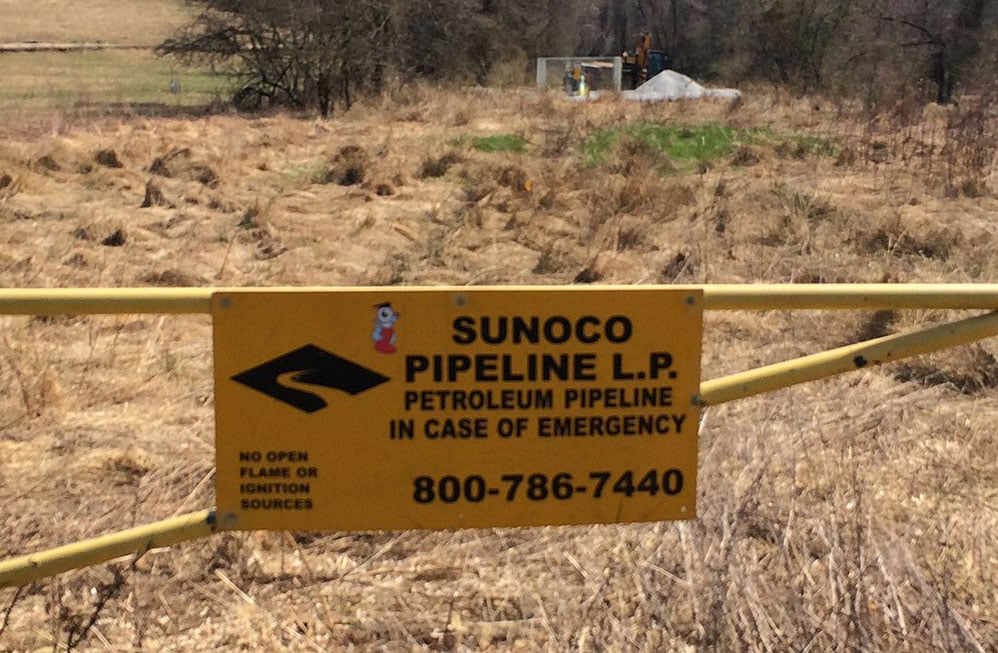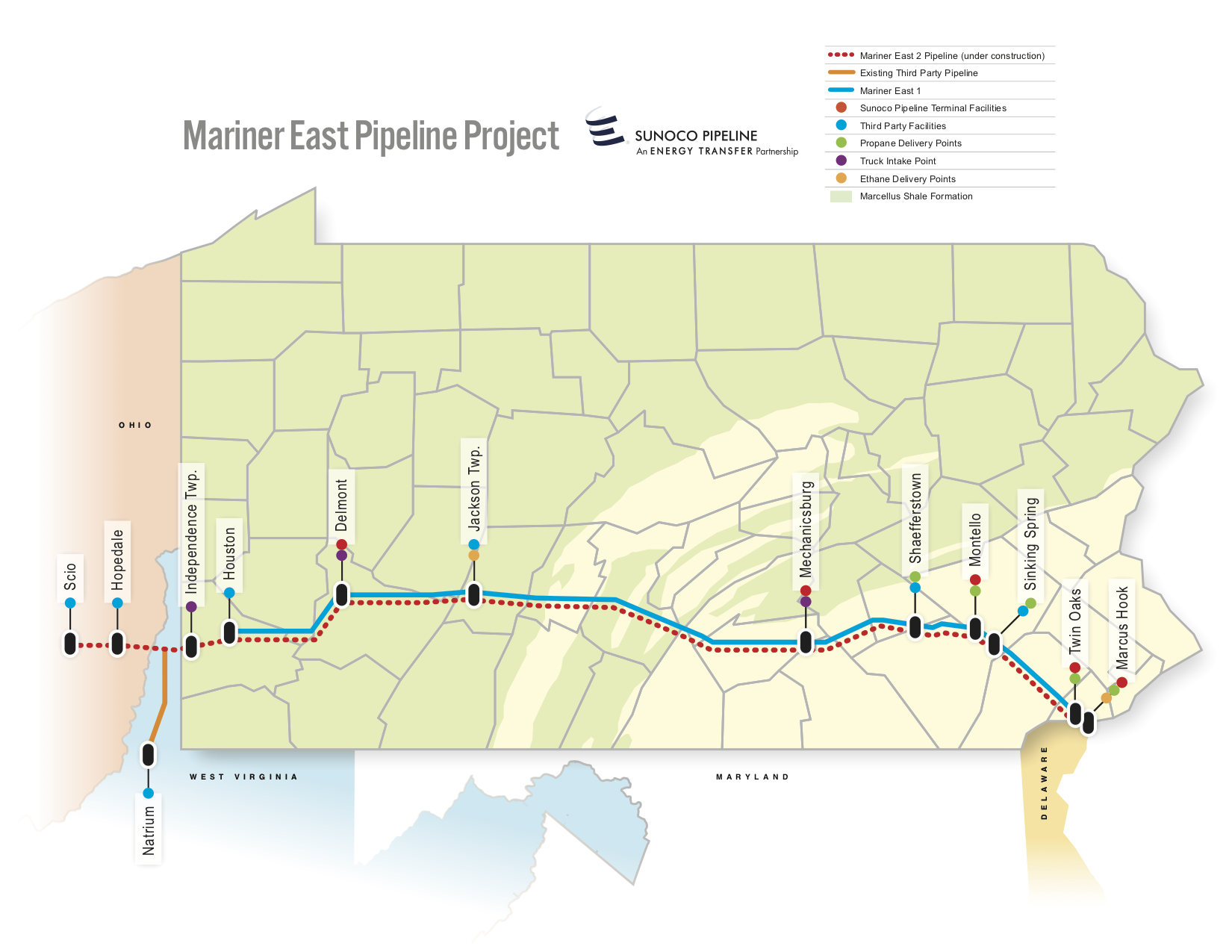
Energy Transfer has begun shipping natural gas liquids through one of the most troubled pipeline projects in Pennsylvania, sparking calls for additional investigations as residents say safety concerns remain unresolved.
Natural gas liquids (NGLs) are fossil fuels found in large volumes in “wet” shale gas wells. They include the highly flammable fuels propane and butane, plus ethane, which is used extensively in the petrochemicals and plastics industy.
A year ago, Pennsylvania temporarily suspended permits for Mariner East 2 pipeline construction, citing the builder’s “egregious and willful violations” of state laws.
Portions of Mariner East 2 construction remain under a separate injunction, this one issued by a state administrative law judge in May, after sinkholes opened up in West Whiteland Township in the densely populated suburbs of Philadelphia.
The Mariner East projects are the subject of a criminal probe by the Chester County district attorney’s office, which announced in December that it was investigating potential charges including risking a catastrophe, criminal mischief, and environmental crimes.
“We expected the state regulators and the governor to step in and assure the safety of Pennsylvanians,” District Attorney Tom Hogan said in a statement announcing the investigation. “They have not.” (Energy Transfer has “vehemently” denied wrongdoing.)
Nonetheless, just before the New Year, Energy Transfer, which owns Sunoco, announced that it was starting to operate the Mariner East 2 pipeline, bypassing more than 20 miles of unfinished construction by using a small 12-inch pipeline originally installed in the 1930s.
Residents were displeased.
“The fact that a dangerous natural gas liquids pipeline was allowed to become operational while PHMSA [U.S. Pipeline and Hazardous Materials Safety Administration] inspectors are furloughed, there is an active criminal investigation by the Chester County District Attorney’s Office, without a comprehensive emergency management plan in place, and after 92 serious DEP [Department of Environmental Protection] violations and counting,” Downingtown mayor Josh Maxwell said, “shows a serious lack of oversight over Sunoco.”
Plagued by Problems
The Mariner East project has proved to be one of the most fraught pipeline projects in recent state history. A November 2018 investigation by Reuters found that between Mariner East 2 and the Rover pipeline, Energy Transfer and its subsidiaries racked up over 800 state and federal permit violations — compared against an average 19 violations for four other large pipeline construction projects.
And the company’s problems have not always ended once construction is finished. “In total, Energy Transfer and its affiliated companies released more than 41,000 barrels of hazardous liquids causing more than $100 million in property damage [from 2010-2017], PHMSA data shows,” Reuters found.
The Mariner East 2 pipeline construction project was most recently cited by state environmental regulators for three spills of drilling fluid in November, including a 1,000 gallon spill into a wetland. The company had failed to notify nearby landowners of that spill in a timely fashion, state regulators found. Four days later, the company spilled into the same wetland again.
In December, two workers were injured during a Mariner East 2 construction accident outside Pittsburgh that left one worker hospitalized with a broken arm.
The 12-inch pipeline that is now part of Mariner East 2 also suffered from corrosion problems and a history of leaks, pipeline opponents said, including a June 2018 leak of 33,000 gallons of gasoline into a Delaware River tributary outside Philadelphia. Jen Batchelder, an Edgmont, Pennsylvania, resident, told NPR’s State Impact that the 12-inch pipe had ruptured on her property in 1992, spilling 100,000 gallons of oil and jet fuel and contaminating portions where she said trees will no longer grow.
The company says it spent $30 million in 2016 upgrading the 12-inch pipe used in Mariner East 2.
A 20-inch, 16-inch, 12-inch “Frankenpipe”?
Mariner East 2 was originally designed as a 20-inch pipeline that could carry 250,000 barrels a day of natural gas liquids (NGLs) across the Marcellus Shale for export by sea — but as the project dragged two years behind schedules and amassed a track record of accidents, dozens of “serious” violations of state laws, and over $13 million in fines, its builder decided to bypass missing sections of the Mariner East 2 project, using stretches of 16-inch pipe from its Mariner 2X project and the 12-inch pipe from the 1930s.
Locals have decried that modified plan, with some residents nicknaming it the “Frankenpipe.”
The company’s been under significant pressure from drillers, who have faced a massive glut of ethane, propane, butane, and other NGLs from fracking the Marcellus Shale. Propane, butane and ethane all fetch higher prices when separated out from “dry” natural gas, or methane.

Energy Transfer has declined to say publicly just how much of these NGLs it is now pumping through the modified Mariner East 2 — an important question for its partners in the oil and gas industry, given the mix of pipe bore sizes now being used. “We have not provided that level of detail at this time,” an Energy Transfer spokesperson told trade publication Natural Gas Intelligence in response to a question about the pipeline’s capacity. “We will provide more information as the pipeline continues to ramp up.”
On September 10, 2018, a massive blast ripped through a town just outside Pittsburgh, as a leak from Energy Transfer’s Revolution pipeline, which was planned to connect to the Mariner East pipeline system, ignited a 150-foot tall column of fire, destroying one home and causing dozens to evacuate.
State regulators discovered in October that the company had failed to report landslides and leaks and engaged in unpermitted construction activities. The 24-inch Revolution pipeline had only been put in service seven days prior to the explosion.
The Mariner East 1 pipeline project, which involved reversing the direction of another 1930s gasoline pipeline and using it to transport 70,000 barrels a day of natural gas liquids, runs parallel to the Mariner East 2 pipeline for most of its route. Since it began moving ethane and propane in 2016, it’s been shut down multiple times by state regulators due to sinkholes along its route.
Safety Debate Swirls
Asked about safety concerns, Energy Transfer spokesperson Lisa C. Dillinger pointed to a risk assessment she said showed that living next to the Mariner East 2 pipeline was less risky than driving a car.
“We are committed not only to following the strict guidelines set forth in our permits but also to employing the highest levels of construction expertise and operational safety mechanisms,” she wrote. “We have said since the start of the ME2[Mariner East 2] project that the safety of the communities and the environments through which we pass is our first priority.”
Dillenger also provided a letter from the Pennsylvania Public Utility Commission’s (PUC) Bureau of Investigation and Enforcement (I&E), sent to three school superintendants along the pipeline’s route. The regulator’s letter described two hydrostatic tests, one in October 2017 and one in September 2018, that found no leaks.
“If a pipeline successfully passes a hydrostatic pressure test, it can be assumed that no hazardous defects are present in the tested pipe,” the PUC wrote. (The letter did not address the leak of 33,000 gallons of gasoline from the 12-inch pipeline, which occurred after the successful 2017 test.)
The PUC letter also described the 12-inch bypass pipeline as “currently holding pressure” and equipped with six automated shut-off valves across its 24.5 mile span. It concluded that the PUC “strongly urge[d]” the schools to update their evacuation plans.
Energy Transfer has previously gotten pushback from state regulators who said the company had misrepresented that PUCletter in a legal filing. The PUC responded that Energy Transfer’s Sunoco subsidiary incorrectly claimed the state concluded the 12-inch pipeline is “safe.”
“Sunoco mischaracterized I&E’s position in this matter in its answer to petitioners’ petition for emergency relief, claiming that I&E acknowledged that respondent’s 12-inch pipeline is ‘safe,’” the PUC wrote in a filing, according to State Impact. “I&E made no such assertion.”
That said, the PUC made clear it was not concluding that the pipeline was dangerous either. “The purpose of this clarification should also not be construed as a testament that the 12-inch line is unsafe,” it wrote, explaining that the responsibility for ensuring safety rests on the company’s shoulders.
In December, the administrative law judge who had ordered the May 2018 shutdown rejected a request to halt operation of Mariner East 1, finding that the petitioners had not shown “a clear and present danger, or an imminent safety risk” along either Mariner East 1 or 2.
With a third Mariner East project, the Mariner East 2X, also underway, some state lawmakers have begun proposing stronger regulation for the industry.
“The battle for strong pipeline safety in Chester County and in Pennsylvania is not over,” State Senator Andy Dinniman said in a statement after the Marine East 2 pipeline went into use. “In fact, in many ways, it’s just beginning.”
“We must remain vigilant and diligent in working to ensure that they are constructed and operated with safety as the top priority,” he wrote. “And we must pass comprehensive legislation to support that end, and rein in the influence of the natural gas industry in Harrisburg.”
Our most important fundraising appeal of the year
December is the most critical time of year for Truthout, because our nonprofit news is funded almost entirely by individual donations from readers like you. So before you navigate away, we ask that you take just a second to support Truthout with a tax-deductible donation.
This year is a little different. We are up against a far-reaching, wide-scale attack on press freedom coming from the Trump administration. 2025 was a year of frightening censorship, news industry corporate consolidation, and worsening financial conditions for progressive nonprofits across the board.
We can only resist Trump’s agenda by cultivating a strong base of support. The right-wing mediasphere is funded comfortably by billionaire owners and venture capitalist philanthropists. At Truthout, we have you.
We’ve set an ambitious target for our year-end campaign — a goal of $250,000 to keep up our fight against authoritarianism in 2026. Please take a meaningful action in this fight: make a one-time or monthly donation to Truthout before December 31. If you have the means, please dig deep.